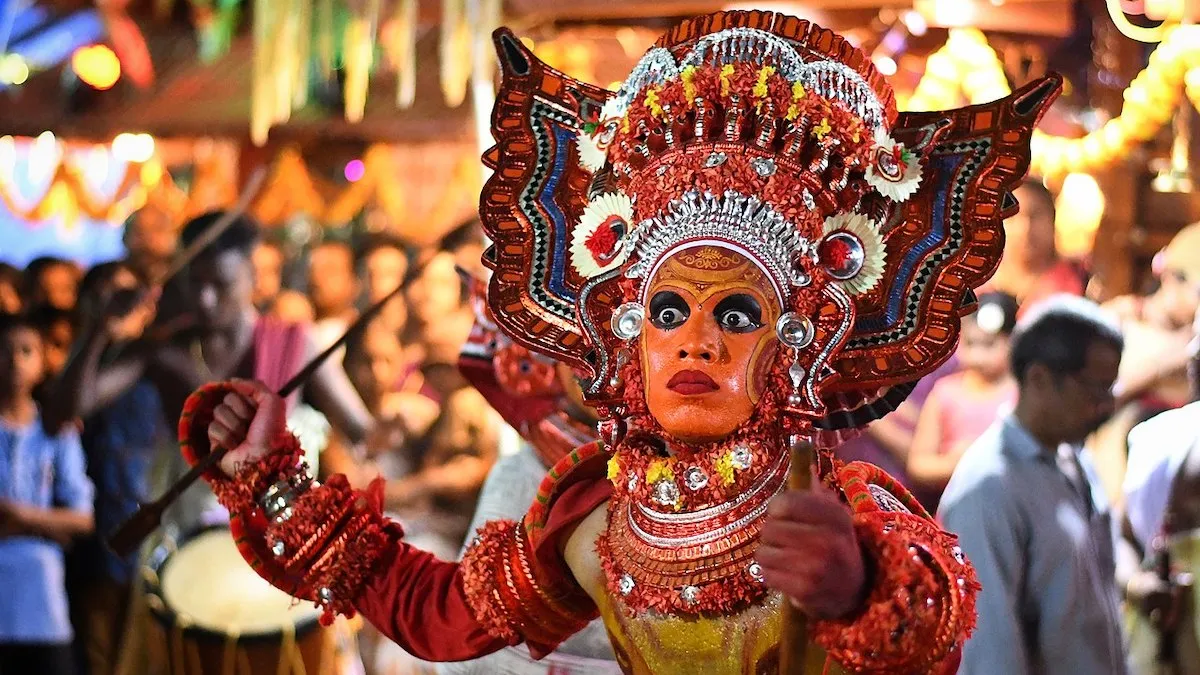Kerala, a lush and vibrant state in the southern part of India, is known for its rich cultural tapestry, breathtaking landscapes, and diverse traditions. Among the many cultural gems that Kerala proudly showcases, the “Theyyam” dance form stands out as a unique and fascinating ritualistic performance that combines elements of dance, drama, and devotion. Often referred to as “Theyyattam,” this centuries-old art form has deep-rooted connections to spirituality and folklore, making it an integral part of Kerala’s cultural heritage. In this comprehensive guide, we will immerse ourselves in the captivating world of Theyyam, exploring its origins, significance, various elements, and the experiences it offers to those who witness it.
Introduction to Theyyam
Theyyam is an extraordinary and captivating form of traditional dance of Kerala, a ritualistic performance that is predominantly practiced in the northern Malabar region of Kerala. It is a vibrant and intricate dance drama that is deeply entwined with local traditions, legends, and spiritual beliefs. Theyyam performances are an essential part of many religious festivals in the region, and they serve as a means of connecting with the divine, expressing devotion, and seeking blessings.
The term “Theyyam” is derived from the Malayalam words “Deivam,” meaning God, and “Aattam,” meaning dance. Therefore, Theyyam can be interpreted as the “Dance of the Gods.” This art form transcends the boundaries of mere entertainment; it is a sacred and mystical experience that reflects the rich culture and spirituality of Kerala.
The Origins and History of Theyyam
The origins of Theyyam can be traced back to ancient tribal cultures, and it has evolved over thousands of years. While the exact historical roots remain somewhat obscure, Theyyam is believed to have its beginnings in the indigenous rituals and practices of the region. These early tribal customs gradually merged with elements of Hinduism and other religious traditions to create the unique form of Theyyam that is practiced today.
It is essential to note that Theyyam is not just a dance form; it is a form of worship. The performers, known as “Theyyam artists” or “Theyyam practitioners,” transform into living deities during the performance. This transformation is believed to be a spiritual journey, and it is a fundamental aspect of the ritual.
The Ritual and Preparation
The preparation for a Theyyam performance is an elaborate and time-consuming process. Here are some key steps in the ritual and preparation:
Invoking the Deity: The first step involves invoking the deity that the performer will embody. This is done through prayers and rituals, often in the sanctum of a temple.
Costume and Makeup: The costumes and makeup used in Theyyam are intricate and colorful. The makeup is primarily made from natural materials like rice powder and turmeric. The artist’s face is painted with vibrant colors, and the costume is equally striking, often adorned with elaborate jewelry and headdresses.
Ornate Headgear: One of the most distinctive features of Theyyam is the ornate headgear worn by the performers. These headpieces, often made of wood and cloth, can be massive and weigh several kilograms. They are meticulously crafted and play a significant role in the character’s representation.
Dance Training: Theyyam artists undergo extensive training in traditional dance and movements. These dances are highly stylized and are integral to the ritual.
Fasting and Austerity: In the days leading up to the performance, the artists typically observe fasting and austerity as a form of purification.
Possession and Transformation: During the performance, the artist undergoes a form of divine possession. It is believed that the deity temporarily enters the performer’s body, enabling them to embody the character fully.
Significance and Symbolism
Theyyam is a spiritual experience that holds immense significance in the lives of the local people. It serves several purposes:
Religious Devotion: Theyyam performances are a form of worship. The participants and the audience both engage in acts of devotion during the ritual.
Blessings and Healing: People seek the blessings of the deity to overcome various challenges, be it health issues, personal problems, or other life obstacles.
Community Bonding: Theyyam performances often take place during festivals, bringing communities together and strengthening social bonds.
Mythical Narratives: Many Theyyam characters are based on ancient myths and legends. The performances narrate these stories, passing down the cultural heritage from generation to generation.
Theyyam Characters and Costumes
Theyyam features a diverse array of characters, each with its own distinct costume, makeup, and characteristics. Some of the prominent Theyyam characters include:
Raktha Chamundi: Raktha Chamundi is known for her fierce appearance. She is portrayed with a terrifying visage, wielding weapons and dancing with intensity.
Muthappan: Muthappan is one of the most revered Theyyam deities. He is often depicted with a string of bells and carries a bow and arrow.
Kari Chamundi: Kari Chamundi is considered the goddess of disease and is believed to possess the power to heal ailments.
Vishnumoorthi: Vishnumoorthi is a representation of Lord Vishnu, one of the principal deities in Hinduism. The performance of Vishnumoorthi is characterized by its graceful and rhythmic dance.
Muchilott Bhagavathi: This Theyyam character is associated with the goddess Bhagavathi, and the performance is marked by the presence of a towering headgear.
Each character has its own set of stories, rituals, and symbolism associated with it.
The Performance: A Divine Dance Drama
The performance of Theyyam is a grand spectacle that takes place in the precincts of temples or specially constructed open-air stages. It typically begins in the evening and continues throughout the night, culminating at dawn. The audience gathers to witness the divine transformation of the artist into the chosen deity. Here are some key aspects of a Theyyam performance:
Intricate Dance: Theyyam performances involve intricate and highly stylized dance movements that are often characterized by slow, rhythmic, and deliberate steps.
Drumming and Music: The music accompanying the performance is provided by traditional instruments such as chenda (drum) and elathalam (cymbals). The drummers set the rhythm for the dance.
Fire and Light: Fire torches are used to illuminate the performance area, creating a mystical atmosphere. The flickering light adds to the overall ambiance of the ritual.
Narration of Stories: The Theyyam artist narrates the stories associated with the deity through song and dance. The stories are often based on local myths and legends.
Audience Participation: The audience actively engages with the performance. It is not uncommon for individuals to seek blessings and guidance from the deity during the ritual.
The Music and Instruments of Theyyam
Music plays an integral role in Theyyam performances. Traditional instruments and rhythmic beats create a mesmerizing atmosphere that complements the dance. Some of the essential musical elements of Theyyam include:
Chenda: The chenda is a cylindrical percussion instrument, similar to a drum. It is played with sticks and is known for its powerful and resonant sound.
Elathalam: Elathalam is a set of cymbals that provide the rhythmic backdrop to the performance.
Kuzhal: The kuzhal is a traditional wind instrument that adds melodic elements to the music.
Edakka: Edakka is another percussion instrument used in Theyyam performances. It is a small drum played with the hands.
Vadyam: The Vadyam ensemble includes various traditional instruments that create a symphony of sound, enhancing the overall musical experience.
Theyyam and Spirituality
Theyyam is deeply rooted in the spirituality and religious beliefs of the people of Kerala. It serves as a direct connection between the human and the divine. The transformation of the artist into a deity is believed to be a sacred act, and the blessings sought from the deity are considered potent and effective.
Theyyam is not limited to one specific religious tradition. It encompasses a wide range of deities and beliefs, including elements of indigenous tribal spirituality and Hinduism. This inclusive nature allows Theyyam to serve as a bridge between different communities and faiths.
Where to Witness Theyyam
Theyyam performances are most commonly held in the northern Malabar region of Kerala, particularly in the districts of Kannur and Kasaragod. These performances are an integral part of various temple festivals and cultural events in the region. Some of the well-known temples where Theyyam is performed include the Parassinikadavu Muthappan Temple, Kalarivathukkal Bhagavathi Temple, and Thaliyil Mahadeva Temple, among others.
The best time to witness Theyyam is during the festival season, which typically spans from December to April. It’s during this period that the performances are at their most vibrant and frequent.
Challenges and Preservation Efforts
Despite its cultural significance, Theyyam faces several challenges, including a decrease in the number of performers and a struggle to adapt to modern lifestyles. In recent years, efforts have been made to preserve and promote this ancient art form.
Various government and non-government organizations are working to provide support and resources to Theyyam artists. Additionally, initiatives are underway to create awareness and encourage the younger generation to take up Theyyam as a vocation.
Theyyam’s Influence on Art and Culture
The influence of Theyyam extends beyond the ritualistic performances. It has left an indelible mark on Kerala’s cultural and artistic landscape. Elements of Theyyam, such as the intricate makeup and costumes, have found their way into contemporary art forms. The vibrant colors and motifs associated with Theyyam can be seen in Kerala’s traditional art and handicrafts.
Furthermore, Theyyam has also inspired literature and cinema. It has been a subject of study for researchers and scholars interested in the culture and traditions of Kerala.
Conclusion: A Living Tradition
Theyyam is not merely a dance form; it is a living tradition that encapsulates the essence of Kerala’s rich and diverse culture. It provides a unique opportunity to witness the seamless blend of spirituality, art, and devotion. Those who have the privilege of experiencing a Theyyam performance find themselves transported to a world where the divine and the earthly meet, where myths come to life, and where the past and present converge in a mystical dance of colors, music, and stories. Theyyam serves as a testament to the enduring spirit of tradition and the eternal quest for the divine that transcends time and generations, making it one of the most captivating and cherished cultural treasures of Kerala.





